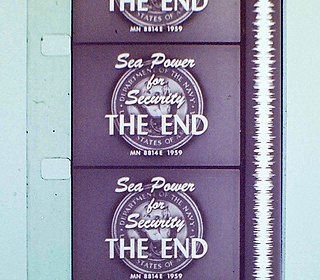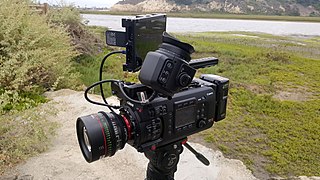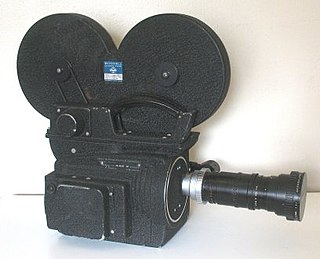Magnetic
Magnetic recording had magnetic media in the area where the optical sound track would be recorded on optical SOF or on release prints. The principal recording stripe was approximately 2 mm wide. A smaller balance stripe existed to compensate the thickness of the recording stripe to keep the film wound evenly. Auricon and Cinema Products Corporation were two popular manufacturers of this type of camera, which were made obsolete by the takeover of video for news shooting in the late 70s.
The main problem with placing a magnetic stripe on film is that the tape head cannot block the projector gate and must be slightly offset, which means that sound and light cannot be recorded on the exact same piece of film. Any given frame will be as far as 24 frames ahead of the corresponding segment of the magnetic stripe. Editing such film by splicing it risks cutting off the current speaker's last syllable.
To edit single-system magnetic film, it was necessary to first run it through a displacement recorder which would read the audio and re-record it backwards 24 frames behind the point where it was recorded. This put the audio in dead sync with the picture. The film was then edited. After editing the film was run through the displacement recorder again, forward this time which put the audio back at the location where the audio playback head would be in the film projector. These additional levels of generation loss explain why the film industry has always preferred double-system recording for professional film projects.

35 mm film is a film gauge used in filmmaking, and the film standard. In motion pictures that record on film, 35 mm is the most commonly used gauge. The name of the gauge is not a direct measurement, and refers to the nominal width of the 35 mm format photographic film, which consists of strips 1.377 ± 0.001 inches (34.976 ± 0.025 mm) wide. The standard image exposure length on 35 mm for movies is four perforations per frame along both edges, which results in 16 frames per foot of film.

70 mm film is a wide high-resolution film gauge for motion picture photography, with a negative area nearly 3.5 times as large as the standard 35 mm motion picture film format. As used in cameras, the film is 65 mm (2.6 in) wide. For projection, the original 65 mm film is printed on 70 mm (2.8 in) film. The additional 5 mm contains the four magnetic stripes, holding six tracks of stereophonic sound. Although later 70 mm prints use digital sound encoding, the vast majority of existing and surviving 70 mm prints pre-date this technology.

16 mm film is a historically popular and economical gauge of film. 16 mm refers to the width of the film ; other common film gauges include 8 mm and 35 mm. It is generally used for non-theatrical film-making, or for low-budget motion pictures. It also existed as a popular amateur or home movie-making format for several decades, alongside 8 mm film and later Super 8 film. Eastman Kodak released the first 16 mm "outfit" in 1923, consisting of a camera, projector, tripod, screen and splicer, for US$335. RCA-Victor introduced a 16 mm sound movie projector in 1932, and developed an optical sound-on-film 16 mm camera, released in 1935.

8 mm film is a motion picture film format in which the film strip is eight millimetres (0.31 in) wide. It exists in two main versions – the original standard 8 mm film, also known as regular 8 mm, and Super 8. Although both standard 8 mm and Super 8 are 8 mm wide, Super 8 has a larger image area because of its smaller and more widely spaced perforations.

Super 8 mm film is a motion-picture film format released in 1965 by Eastman Kodak as an improvement over the older "Double" or "Regular" 8 mm home movie format.

9.5 mm film is an amateur film format introduced by Pathé in 1922 as part of the Pathé Baby amateur film system. It was conceived initially as an inexpensive format to provide copies of commercially made films to home users, although a simple camera was released shortly afterwards.

A movie camera is a type of photographic camera that rapidly takes a sequence of photographs, either onto film stock or an image sensor, in order to produce a moving image to display on a screen. In contrast to the still camera, which captures a single image at a time, the movie camera takes a series of images by way of an intermittent mechanism or by electronic means; each image is a frame of film or video. The frames are projected through a movie projector or a video projector at a specific frame rate to show the moving picture. When projected at a high enough frame rate, the persistence of vision allows the eyes and brain of the viewer to merge the separate frames into a continuous moving picture.
Pilottone and the related neo-pilotone are special synchronization signals recorded by analog audio recorders designed for use in motion picture production, to keep sound and film recorded on separate media synchronised. Before the adoption of timecode by the motion picture industry, pilotone sync was used in almost all 1/4-inch magnetic double system motion picture sound recording from the late 50s until the late 1980s. Previous to the introduction of 1/4-inch audio tape recordings were made on 35mm optical cameras and then later, with the introduction of magnetic recording, 16mm or 35mm magnetic stock. The first 1/4-inch recorder capable of recording a synch track to regulate the playback speed of the recording was made by Rangertone and was a variation on the soon to come pilotone system.

A movie projector is an opto-mechanical device for displaying motion picture film by projecting it onto a screen. Most of the optical and mechanical elements, except for the illumination and sound devices, are present in movie cameras. Modern movie projectors are specially built video projectors.

Sound-on-film is a class of sound film processes where the sound accompanying a picture is recorded on photographic film, usually, but not always, the same strip of film carrying the picture. Sound-on-film processes can either record an analog sound track or digital sound track, and may record the signal either optically or magnetically. Earlier technologies were sound-on-disc, meaning the film's soundtrack would be on a separate phonograph record.
Sync sound refers to sound recorded at the time of the filming of movies. It has been widely used in movies since the birth of sound movies.
Offline editing is the creative storytelling stage of film making and television production where the structure, mood, pacing and story of the final show are defined. Many versions and revisions are presented and considered at this stage until the edit gets to a stage known as picture lock. This is when the process then moves on to the next stages of post production known as online editing, colour grading and audio mixing.

Sound recording and reproduction is the electrical, mechanical, electronic, or digital inscription and re-creation of sound waves, such as spoken voice, singing, instrumental music, or sound effects. The two main classes of sound recording technology are analog recording and digital recording.
The history of sound recording - which has progressed in waves, driven by the invention and commercial introduction of new technologies — can be roughly divided into four main periods:

A film chain or film island is a television – professional video camera with one or more projectors aligned into the photographic lens of the camera. With two or more projectors a system of front-surface mirrors that can pop-up are used in a multiplexer. These mirrors switch different projectors into the camera lens. The camera could be fed live to air for broadcasting through a vision mixer or recorded to a VTR for post-production or later broadcast. In most TV use this has been replaced by a telecine.

Standard 8 mm film, also known as Regular 8 mm film, Double 8 mm film, or simply as Standard-8, Regular-8 or Double-8 is an 8 mm film format originally developed by the Eastman Kodak company and released onto the market in 1932.

Optical sound is a means of storing sound recordings on transparent film. Originally developed for military purposes, the technology first saw widespread use in the 1920s as a sound-on-film format for motion pictures. Optical sound eventually superseded all other sound film technologies until the advent of digital sound became the standard in cinema projection booths. Optical sound has also been used for multitrack recording and for creating effects in some musical synthesizers.

Auricon cameras were 16 mm film Single System sound-on-film motion picture cameras manufactured in the 1940s through the early 1980s. Auricon cameras are notable because they record sound directly onto an optical or magnetic track on the same film as the image is photographed on, thus eliminating the need for a separate audio recorder. The camera preceded ENG video cameras as the main AV tool of television news gathering due to its portability–and relatively quick production turn-around–where processed negative film image could be broadcast by electronically creating a positive image. Additionally, the Auricon found studio use as a 'kinescope' camera of live video off of a TV screen, but only on early pre-NTSC line-locked monochrome systems.

Multi-image is the now largely obsolete practice and business of using 35mm slides (diapositives) projected by single or multiple slide projectors onto one or more screens in synchronization with an audio voice-over or music track. Multi-image productions are also known as multi-image slide presentations, slide shows and diaporamas and are a specific form of multimedia or audio-visual production.

A sound follower, also referred to as separate magnetic, sepmag, magnetic film recorder, or mag dubber, is a device for the recording and playback of film sound that is recorded on magnetic film. This device is locked or synchronized with the motion picture film containing the picture. It operates like an analog reel-to-reel audio tape recording, but using film, not magnetic tape. The unit can be switched from manual control to sync control, where it will follow the film with picture.











